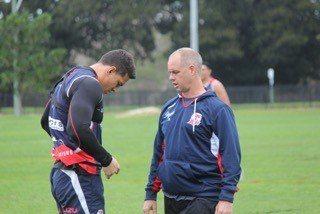
In July of 2015, Australian performance specialist Lachlan Penfold joined the NBA’s Golden State Warriors as Head of Physical Performance and Sports Medicine. The Warriors, led by newly crowned league MVP Stephen Curry, had just won the team’s first NBA Championship in forty years. One frequently cited key to the Warriors new found success was a willingness to put pieces together in new, sometimes unexpected, ways.
Penfold joined the Warriors with little experience working with elite basketball players and no prior experience in the NBA. What he brought to the team was a rich legacy as a successful trainer with expertise in recovery management. Over his 20 year career in Australia, he worked with more than 80 Olympic athletes over 5 different Olympic games. Immediately before joining the Warriors, he held key positions in various football codes, including 7 years in Australian Rules Football with the Brisbane Lions and 3 years in the National Rugby League with the Sydney Roosters, culminating in their premiership run in 2013. Penfold was most recently with the Australian National Sevens squad immediately before joining the Warriors.
How does data inform decisions at different stages of the game week and season? Listen to the Firstbeat Sports Podcast to find out
Throughout his professional career, Penfold has championed the importance of developing individualized training plans that are easily adapted to the changing needs of athletes.
The ability to measure and quantify are critical steps in the process of improvement and management. Monitoring data and analytics are critical for Penfold as he works to ensure that his training plans are tailored to each player’s needs, signalling to him when it might be time to make a change.
Internal and External Load Quantification
Internal and external load quantification are two critical topics for elite performance specialists. In this context, external loading refers to the amount of work performed by the athlete, and internal loading refers to the individual athlete’s physiological response to that workload. Each of these dimensions poses unique challenges in terms of data collection and analysis needed to gain meaningful insights from the raw data.
In recent years, objective external load monitoring in team sports has improved substantially thanks to advances in accelerometer and GPS technologies. In addition to reducing subjectivity, these advances have simplified and streamlined the external load tracking process and improved accuracy. The road to developing strong internal load quantification methods capable of delivering real-time feedback hasn’t been quite as straightforward.
As early as the 1980’s, heart rate monitors were offered as a potential game changer for internal load quantification. Unfortunately for optimistic early adopters, the dynamic nature of physiological systems and variation between individuals complicates the interpretation and application of raw heart rate data for training evaluation and guidance. Almost from the beginning it was clear that the value of this data would be directly tied to the the analytics used to interpret it.
A blend of sports science, technology, advanced analytics have made significant progress in helping coaches, trainers, and athletes make sense of these critical variables.
In his previous work with the Sydney Roosters, and also with the Warriors, Penfold utilizes a combination of the most advanced monitoring and analytic platforms available. During team training activities he keeps two programs open on his laptop. It is no coincidence that these programs mirror the desire for internal and external load quantification.
External load data is provided by Catapult, an Australian sports tracking company known for wearable GPS devices for athletes. Meanwhile internal load quantification and analysis is handled by Firstbeat Sports. Based in Finland, Firstbeat uses heartbeat data to produce individualized dynamic models of physiological systems. Among other things, these models are capable of making real-time assessments of exertion and recovery levels with near laboratory grade accuracy.

Player Adoption
When it comes to player familiarity with monitoring and the benefits it offers, Penfold has observed differences between the US and Australia. “A lot of players in Australia have been exposed to monitoring methods for quite a while. Players there are quite used to having monitoring devices on and expect to wear them. Whereas in the US it’s a lot newer, and a lot of current players have come through college systems and development without being exposed to this equipment.”
Regardless of whether they are in Australia, the UK, or America, athletes tend to approach monitoring data and analytics with a natural sense of competitiveness. Questions from players visiting Penfold’s monitoring station like “What’s my heart rate?” and “What’s my TE-score?” quickly transform into questions about how they did relative to the rest of the team or another player specifically.
As Veli-Pekka Kurunmäki who heads Firstbeat’s Sports division contributes, ”Advanced analytics are what makes these interplayer comparisons possible. Variations in individual physiology make it difficult, if not impossible, to directly compare pure heart rate data. An advanced metric like our Training Effect transforms that data into manageable information that can be exchanged”
Putting Monitoring Data to Work
At the start of a training session, Penfold prepares and distributes a Catapult GPS pod and Firstbeat chest strap for each player. He sets up the receivers to capture radio signals from the monitoring devices and send data to his courtside laptop. This arrangement provides real-time feedback during training which is vital for making on-the-fly training adjustments.
He keeps the software for both systems running on his computer simultaneously and flips between screens as needed. Although, “Most of the time I tend to leave it on the heart rate information, just because that information is typically of more interest to the players, if they come over to have a look,” he explains.
With Firstbeat’s heart rate variability analytics, Penfold has access to a lot more than just simple heart rate measurement. Coded into each player heartbeat data is a wealth of information just waiting to be unlocked. Firstbeat’s smart analytics are used to provide respiration rates, oxygen consumption, VO2max prediction, training impulse, and more. Advanced analytics like Training Effect, reported as a TE-score, reveal how specific activities impact individual player fitness levels. Meanwhile a variety of recovery tests, some of which can be performed in as little as 5 minutes, indicate warning signs of fatigue and help determine player readiness.
Individualizing for Performance
Small roster size and position specialization make the NBA a perfect opportunity to maximize the potential of an individualized approach to performance and recovery management.
“We’ve got 15 players and every player is different and [over the course of an 82 game season] there are a lot of combinations. A player may have high minutes or low minutes depending on what they can contribute on a given night and each player has a different training schedule. As a very basic example, some players prefer to do strength training either before practice or after practice.”
“From the outside it probably looks random and chaotic. Different people doing different things at different times. But it is really about trying to be as individualized as possible and working out what’s best for each player in terms of setting up their daily schedule and implementing that program. It’s about trying to find the routines and systems that work for individual players, and then enhancing and improving upon these.”
The NBA’s notoriously grinding 82-game regular season adds a layer of difficulty to performance and recovery management. Teams can play as many as 9 games in 14 days which reduces practice and adjustment opportunities to a minimum. Deep in the season actual games take the place of practice sessions, especially during road trips.
When direct monitoring is unavailable, past experience is a valuable professional resource for assessing individual and team needs.
In rugby league, teams typically complete only once a week. Consistent space between games allowed Penfold to use Firstbeat’s technology to develop a comprehensive systematic approach to load quantification.
“When I was working with the Sydney Roosters we used the heart rate variability feature quite frequently, on average 3-4 times in a week,” he explains. Firstbeat’s load quantification was particularly important during the preseason as the team was molded into competitive shape. “In a typical preseason week we’d have 5-6 days of work and 1-2 days of recovery. The team usually had Sunday off, so we would start testing the first day back on a Monday. We’d do it on a Wednesday which was a lower intensity recovery day after two hard days of training, we’d do it on the Thursday following our recovery day, and we’d do it on the Saturday as a measure of where we’re at come the end of the week – so we had four markers during the week.”
During the season, Penfold adapted his monitoring schedule around games. “In season we typically ran the heart rate variability tests two days post-game, two days before games, and then we’d get at least one or two other markers in there depending on what our game schedule was like.”
“This was a learning process for me,” he continues. “Sometimes we would look at group trends, but it was more about how each player was in relationship to themselves over the season. How a player was doing on this Monday compared to a normal Monday? Are they up or down? How are they affected by travel? How are they doing at the end of the week compared to the beginning? Are they recovering effectively?”
Penfold also finds that simply talking to players can provide valuable material. In this sense, he explains that the best approach to performance development requires a variety of tools. “If a player’s heart rate variability indicator is low, it could be an indicator of fatigue, “ he explains. “It shouldn’t be used as a sole decision maker, but as a tool that enhances the decision making process and a sign that things may need closer examination.”
Training camps are great learning opportunities with regards to recovery management. “One of the things we did, which I believed was a crucial part of our preparation, was we had a very hard training camp in the week leading into our christmas break, so we looked at heart rate variability through that camp, as well. We were trying for a form of over-reaching, not over-training, but really trying to stress them hard in that week before they went and had 10 days off, after 6 weeks of increasing load. So hopefully, we’d get to see the recovery effect from that as well. So measuring heart rate variability through that was quite interesting as a significant change from normal.”
The Future
As the influence of monitoring and physiological analytics grows, Penfold hopes for better understanding and management of individual training prescription and dosages. “I think all the monitoring equipment is leading to how you find the optimal training dose for every player… at the end of the day you’re still trying to find the optimal training dosage, whether it’s strengthening work, conditioning work, on-court work – that every player needs. It’s about what benefits them,” he explains.
Ultimately, performance specialists and elite athletes are jointly working out solutions to some essential questions. What level of work output can the athlete deliver? What effect does work have on them? And how long does it take to recover? The combination of heart monitoring and advanced analytics have proven to offer great insight for addressing these questions. As a result, more and more elite teams around the world are relying on these methods to individualize training and maximize team performance.
If you liked this article, you should subscribe to our mailing list.
Give your team the Firstbeat Sports competitive advantage.
Contact us for more information or get a quote.
You might also be interested in

Why Monitor Internal Load in Elite Sports?
A look at the what, how and why of internal load monitoring and why it should form part of your training program.

3 Types of Psychological Stress Affecting Athletes In-season
What exactly are these stressors and how can coaches and athletes identify them in order to adjust and, ultimately, limit the negative impact they can have?

How to Use Training Effect: The Firstbeat Sports Feature that Measures the Impact of Training
In this article, we look at how Training Effect is calculated, the Training Effect scale, and how it is visualized in Firstbeat Sports.

